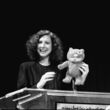Silent music: a story of Baghdad
Description
WHEN BOMBS BEGIN TO FALL, Ali drowns out the sould of war with a pen.Like other children living in Baghdad, Ali loves soccer, music and dancing, but most of all, he loves the ancient art of calligraphy. When bombs begin to fall on his city, Ali turns to his pen, writing sweeping and gliding words to the silent music that drowns out the war all around him. Gorgeously illustrated with collage, pencil and charcoal drawings and, of course, exquisite calligraphy, this timely and yet universal story celebrates art and history but also offers young children a way to understand all they see and hear on the news.Silent Music is a 2009 Bank Street - Best Children's Book of the Year.
More Details
Similar Titles From NoveList
Similar Authors From NoveList
Published Reviews
Booklist Review
My name is Ali. I live in Baghdad. In just a few lines per page, a young Iraqi boy describes his favorite things: soccer, loud parent-rattling music, dancing, and, most of all, Arabic calligraphy: I love to make the ink flow . . . stopping and starting, gliding and sweeping, leaping, dancing to the silent music in my head. When bombs fall on the city, Ali, inspired by his hero, Yakut, a thirteenth-century calligrapher, calms himself with his pen: I filled my room with pages of calligraphy. I filled my mind with peace. Rumford, who has included Arabic calligraphy in previous titles, such as Calabash Cat and His Amazing Journey (2003), fills his multimedia collages with large, looping script that spells out the words and phrases that Ali writes. Many children will have questions about Arabic writing and where the individual letters stop and start, but they'll connect with Ali's first-person voice, which echoes the calligraphy's graceful rhythm and tells a simple, powerful story about a child's everyday survival and hope in wartime Baghdad.--Engberg, Gillian Copyright 2008 Booklist
Publisher's Weekly Review
Art sings on the pages of this visual celebration of Arabic calligraphy as Rumford's (Sequoyah) collages of floral and geometric designs and flowing lines deftly echo Arabic language and patterns. "Writing a long sentence is like watching a soccer player in slow motion as he kicks the ball across the field, as I leave a trail of dots and loops behind me," says narrator Ali, explaining his love of calligraphy. Spreads incorporating stamps, money and postcards reinforce the Baghdad setting and complement representational scenes, such as an intricate collage of Ali huddling under a blanket next to his cat, writing. Arabic words, translated in places, sometimes embed in the pages as part of the illustrations, even patterning Ali's mother's dress. Like his hero, the famed calligrapher Yakut, who wrote through the destruction of Baghdad in 1258 ("he shut out the horror and wrote glistening letters of rhythm and grace"), Ali turns to calligraphy during the bombing of Baghdad in 2003. In an eloquent ending, he discovers that while the word "war" flows easily, the pen "stubbornly resists me when I make the difficult waves and slanted staff of salam--peace." Ages 4-8. (Mar.) (c) Copyright PWxyz, LLC. All rights reserved
School Library Journal Review
Gr 2-6-Ali describes how he loves soccer; "loud, parent-rattling music"; and calligraphy-forming the elegant Arabic letters, pen "gliding and sweeping, leaping, dancing to the silent music in my head." His "secret hero" is Yakut, a renowned 13th-century calligrapher, and Ali tells how, when Mongols invaded Baghdad in 1258, the man fled to a high tower to shut out the violence by creating beauty, writing "glistening letters of rhythm and grace." Similarly, the boy sought solace from the missiles and bombs that fell on the city in 2003 by practicing calligraphy in his room. Since then, "one war has become another," and he continues to write, contemplating how some words, like "HARB-war," flow easily from the pen, while others, like "SALAM-peace," are more difficult to perfect. Jewel-toned illustrations done in pencil and charcoal and then computer enhanced accompany the lyrical text. Ali and his family are depicted with warmth and personality, and their interactions add intimacy to the story. Elaborately detailed designs appear throughout-intricate tile arrangements, delicate floral motifs, colorfully patterned clothing, even a backdrop that incorporates subtle images of warfare (army vehicles, helicopters, etc). Graceful lines of calligraphy flow across and are incorporated into the artwork. In addition to engendering appreciation for this art form, Rumford's book sheds light on life in war-torn Iraq and builds empathy for those caught in the crossfire.-Joy Fleishhacker, School Library Journal (c) Copyright 2010. Library Journals LLC, a wholly owned subsidiary of Media Source, Inc. No redistribution permitted.
Horn Book Review
(Primary) Ali, a young boy growing up in contemporary Baghdad, likes soccer, loud music, and dancing. But more than anything, he loves to create the letters of Arabic calligraphy. He loves the right-to-left movement, the flow of the ink from his pen "stopping and starting, gliding and sweeping, leaping, dancing to the silent music" in his head. His hero is Yakut, the thirteenth-century calligrapher who is thought to have fled to a high tower to write and "shut out the horror" when his Baghdad was destroyed by war. In the first-person text, Ali is a boy any child can understand, and when he writes his sister's name, Yasmin, and describes it as easy and beautiful, we know he is expressing brotherly affection. Later, when he has no trouble writing harb, the word for war, but struggles to draw the word for peace, sala-m, readers will feel Ali's pain for his country. Rumford's mixed-media illustrations echo the collage work of Ezra Jack Keats and Patricia Polacco while still being all about the calligraphy. Told plainly and without bathos, this is one story of how people use art to find understanding. (c) Copyright 2010. The Horn Book, Inc., a wholly owned subsidiary of Media Source, Inc. No redistribution permitted. All rights reserved.
Booklist Reviews
"My name is Ali. I live in Baghdad." In just a few lines per page, a young Iraqi boy describes his favorite things: soccer, loud "parent-rattling" music, dancing, and, most of all, Arabic calligraphy: "I love to make the ink flow . . . stopping and starting, gliding and sweeping, leaping, dancing to the silent music in my head." When bombs fall on the city, Ali, inspired by his hero, Yakut, a thirteenth-century calligrapher, calms himself with his pen: "I filled my room with pages of calligraphy. I filled my mind with peace." Rumford, who has included Arabic calligraphy in previous titles, such as Calabash Cat and His Amazing Journey (2003), fills his multimedia collages with large, looping script that spells out the words and phrases that Ali writes. Many children will have questions about Arabic writing and where the individual letters stop and start, but they'll connect with Ali's first-person voice, which echoes the calligraphy's graceful rhythm and tells a simple, powerful story about a child's everyday survival and hope in wartime Baghdad. Copyright 2008 Booklist Reviews.
Publishers Weekly Reviews
Art sings on the pages of this visual celebration of Arabic calligraphy as Rumford's (Sequoyah ) collages of floral and geometric designs and flowing lines deftly echo Arabic language and patterns. "Writing a long sentence is like watching a soccer player in slow motion as he kicks the ball across the field, as I leave a trail of dots and loops behind me," says narrator Ali, explaining his love of calligraphy. Spreads incorporating stamps, money and postcards reinforce the Baghdad setting and complement representational scenes, such as an intricate collage of Ali huddling under a blanket next to his cat, writing. Arabic words, translated in places, sometimes embed in the pages as part of the illustrations, even patterning Ali's mother's dress. Like his hero, the famed calligrapher Yakut, who wrote through the destruction of Baghdad in 1258 ("he shut out the horror and wrote glistening letters of rhythm and grace"), Ali turns to calligraphy during the bombing of Baghdad in 2003. In an eloquent ending, he discovers that while the word "war" flows easily, the pen "stubbornly resists me when I make the difficult waves and slanted staff of salam —peace." Ages 4-8. (Mar.)
[Page 80]. Copyright 2008 Reed Business Information.School Library Journal Reviews
Gr 2–6— Ali describes how he loves soccer; "loud, parent-rattling music"; and calligraphy—forming the elegant Arabic letters, pen "gliding and sweeping, leaping, dancing to the silent music in my head." His "secret hero" is Yakut, a renowned 13th-century calligrapher, and Ali tells how, when Mongols invaded Baghdad in 1258, the man fled to a high tower to shut out the violence by creating beauty, writing "glistening letters of rhythm and grace." Similarly, the boy sought solace from the missiles and bombs that fell on the city in 2003 by practicing calligraphy in his room. Since then, "one war has become another," and he continues to write, contemplating how some words, like "HARB—war," flow easily from the pen, while others, like "SALAM—peace," are more difficult to perfect. Jewel-toned illustrations done in pencil and charcoal and then computer enhanced accompany the lyrical text. Ali and his family are depicted with warmth and personality, and their interactions add intimacy to the story. Elaborately detailed designs appear throughout-intricate tile arrangements, delicate floral motifs, colorfully patterned clothing, even a backdrop that incorporates subtle images of warfare (army vehicles, helicopters, etc). Graceful lines of calligraphy flow across and are incorporated into the artwork. In addition to engendering appreciation for this art form, Rumford's book sheds light on life in war-torn Iraq and builds empathy for those caught in the crossfire.—Joy Fleishhacker, School Library Journal
[Page 121]. Copyright 2008 Reed Business Information.






























